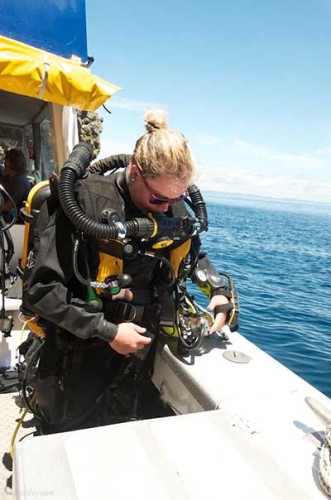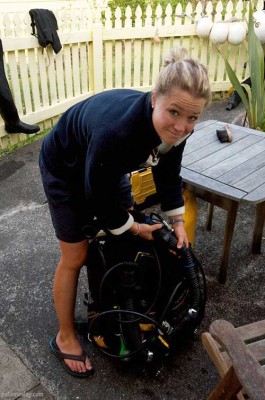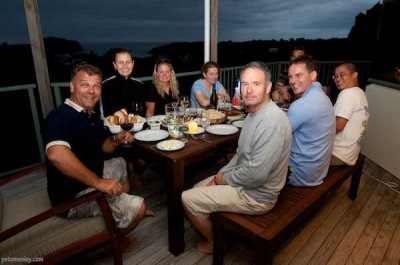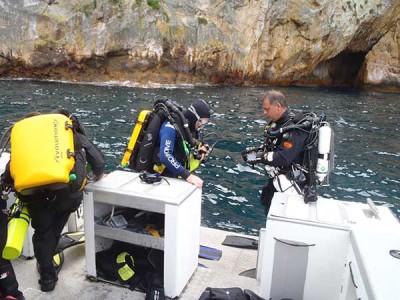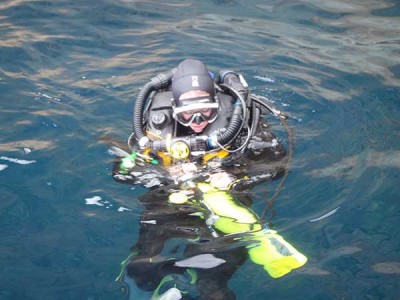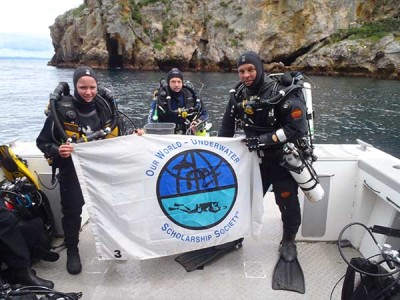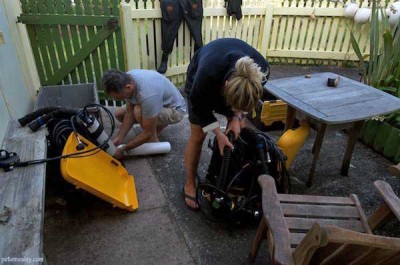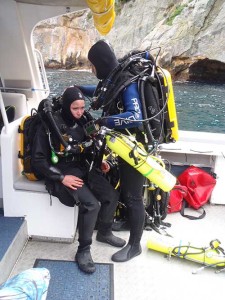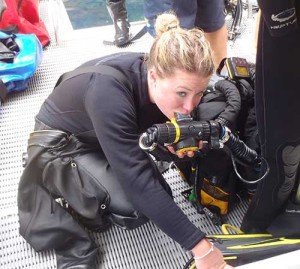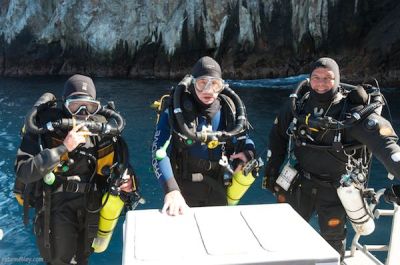“WARNING! If you fail to watch your ppO2 and understand the implications – you will die, it is only a question of where and when.”
So closed circuit rebreather (CCR) diving is a pretty serious game then. It undoubtedly requires a level of alertness and confidence beyond anything I have experienced during my open circuit training. These innovative machines demand and deserve respect, as the manual clearly states:
“Attitude keeps you alive: Normally, closed circuit rebreathers are used by experienced open-circuit divers. This can bring a level of over-confidence which can lead to serious problems. You are a novice again, please accept that…”
There is no denying that I was a novice when it came to my training on the Evolution+; a CCR designed and manufactured by Ambient Pressure Diving. The training was a challenge – it reminded me of how difficult, terrifying and rewarding learning to dive can be. Fortunately for me I had an instructor who instilled alertness and confidence in me and by the end of a week that entailed early starts, late nights, intense dives, CCR theory running on repeat through my mind and a few cheeky merlots I had a huge appreciation for this not so little yellow box of delights.
Learning to use a CCR is a privilege. When Pete Mesley offered me a place on his Level 1 Inspiration and Evolution Diver Course, which would be taking place in the stunning country of New Zealand, I readily agreed to the challenge. This opportunity was huge and it is thanks to a number of people that I was able to take up Pete’s offer.
Pete provided full training and organized all the logistics while Dr Simon Mitchell very generously and boldly lent me his very own Evolution+ for the duration of the course (needless to say I was constantly terrified that I was going to break this £5400). Fellow student Brendan provided accommodation in his gorgeous beachfront cottage for the first few days of the course as we mastered the theory and undertook our first dives in the Kai Iwi Lakes. When it came to the open water dives we moved east to Tutukaka where we would be diving the Poor Knights – famously rated by Jacque Cousteau as one of the top ten dive sites in the world. In Tutukaka Pete’s friends Greg and Nikki allowed us to stay in their stunning home on the Tutukaka coastline. In-fact Greg and Nikki were kind enough to let what amounted to an entire dive club stay at their place and their garage was swiftly turned into the equivalent of an Ambient Pressure Diving showroom.
The local dive center – Dive! Tutukaka – provided all my diving out in the Poor Knights during my course and the lovely intern Claudia kept the hot chocolates rolling – I doubt I would have survived without them. The Poor Knights is a wonderful dive destination and for me it was just the type of diving I wanted to do: a temperate water destination with marine reserve status. But for the vast majority of the course I was so focused on not killing myself that many of the highlights of the Poor Knights passed me by.
As Pete, Brendan and I jumped in for our first dive at the Pinnacles the current was ripping. But lets not bypass the difficulty of that initial jump here. Having just successfully donned 30+kg worth of bulky equipment (people would have been surprised to find a human was actually hiding underneath it all) I lumbered toward the back of the boat. Now most of us divers have contended with the oh so ungraceful fin walk at some stage – maneuvering across the boat with our fins on, a little wobble here, an awkward shuffle there and much to my hilarity now and again you even get the full on tumble. Add a rebreather and a bail-out bottle into the mix and you have a real test of your boat balance aptitude. I can guarantee you if there had been any swell that day I would have been a goner. As it happened I successfully made it to the back of the boat – flanked by Dive! Tutukaka crew members – and lobbed myself off the boat.
As I descended, the long-tailed stingrays swarmed underneath, all I could focus on was: Bubble checks; switching to a high O2 set point on the bottom; attaining my minimum loop volume; figuring out neutral buoyancy without using my lungs; monitoring my diluent, O2 and bail out gauges; checking my wrist mounted display and all the while trying not to let the current sweep me out of sight.
As confusing and overwhelming as all this sounds I did begin to appreciate the amazing surroundings of the Poor Knights and the benefits of using the Evolution+ as the course progressed. The pre-dive/between dive/post-dive checks became ingrained in my memory. Lugging the unit onto my back and clipping the bail out bottle under my shoulder became less of a struggle. I began remembering to switch to a high O2 set point upon reaching the bottom and to switch back to a low set point at the safety stop. I even made it to the back of the boat, fins on, without an entourage.
In terms of the underwater experience, the contrast to open circuit diving really began to strike me. Not only are CCRs less invasive pieces of equipment with their absence of bubbles and associated silence, they also allow extremely long bottom times. Our dives were pushing 90-minutes at an average depth of 20m. While diving through the kelp fronds of the Poor Knights I found it remarkable that the fish didn’t scatter at the sight of me and the stingrays grazed past. Just as I was beginning to enjoy the serenity and silence of diving with the Evolution+ CCR, Pete instigated the ALARM! drills.
So there I would be, lumbering along quite content with my yellow backpack on and my little yellow bail out bottle neatly clipped to my side. The rainbow wrasse would be swimming circles in front of my mask as schools of King Fish streamed along the wall, unperturbed by our presence. ALARM! Pete had swung in with the dreaded ALARM! card – a cue for me to look at my wrist mounted display to simulate discovering the cause of the alarm. I would liken the feeling I had when these ALARM! drills came along to being on the verge of sleep after a long day and being suddenly and unexpectedly woken by your phone ringing. Unfortunately when you have a rebreather strapped to your back and a Mr Pete Mesley floating in front of your face waiting expectantly for you to perform a smooth dill flush/cell check/battery check/switch to bail out/O2 pressure check etc etc….. ignoring the call and continuing with your contented sleep is not an option.
So having duly looked at my wrist mounted display I would tentatively glance toward Pete to discover which of the many drills I was about to have to perform, all the while losing control of the neutral buoyancy I had so proudly achieved. If the card read “Low Oxygen” the procedure was supposed to go as follows:
- Check the oxygen gauge, if it reads empty check the oxygen valve is on.
- If the valve is not on then turn it on, problem should be solved.
- If the valve is on but the gauge is still reading empty then you need to inject diluent into the loop to bring the partial pressure (pp) of O2 up.
- But if the gauge shows there is plenty of O2 in the cylinder then the oxygen controller and solenoid are failing to supply O2 to the loop. In this situation you need to use the O2 inflator to manually increase the ppO2.
Confused yet?
With a number of drills such as this to master my mind was continuously abuzz with drill procedures. At first it was a challenge to remember the relevant procedures for the relevant drills, but as the course progressed I discovered the theory and practical sides of the course began to amalgamate. Pete had taught Brendan and I to think logically and instead of just robotically performing the required steps for a specific drill I found myself thinking – what could be the reason for this particular alarm and what is the logical way to resolve the situation?
This is a critical aspect of CCR diving. Full comprehension of the unit is a necessity. Not only do you need to understand the basics of how a CCR works, you also need to grasp why and how things can go wrong. If you understand this then there is a high chance things will never go wrong for you. Pete ensured both Brendan and I understood our units inside out. For every question we asked Pete would first ask us “well why might that be/what could’ve caused that/if you do that what do you think will happen…?”
Pete’s thoroughness made for a difficult and exhausting course, but I wouldn’t have had it any other way. CCR diving is serious and unfortunately it is often plagued by stories of deaths and injuries. It is a safe and extremely advantageous way to dive if you learn and follow the rules, complete your checks, respect the unit and appreciate your own abilities. I view CCRs as extremely valuable tools in ocean exploration, scientific discoveries and military operations. Many people are critical of CCRs, or believe they are not worth the hassle. Perhaps they aren’t for a 40-minute cruise along a reef. But in the right situations these units make complete sense.
Some opportunities you come across as a scholar are just huge. Learning to dive on the Evolution+ with Pete was one such opportunity. Being able to dive on a CCR is a valuable skill – I can now see new opportunities arising for exploring the world’s oceans. Now thanks to an exceptionally generous sponsorship from Ambient Pressure Diving there will be a (not so) little yellow box of delights waiting for future scholars to train and dive on with Pete when they travel to New Zealand. Enjoy it future scholars!
